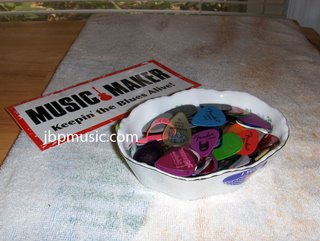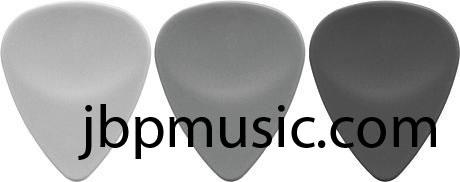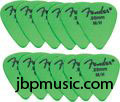Clayton USA Three-Sided Rounded Triangle Acetal and Ultem Guitar Pick Review
Clayton Three-Sided Rounded Triangle acetal and Ultem Guitar Picks Review
It has been a while since I reached into my pick bowl and brought one out for a review to share with everyone. I think one of my often-chosen favorites is one of my Clayton rounded triangle picks. I have several thicknesses and materials. The two big-time favorites of the bunch are the acetal .80mm triangles and the .56mm Ultem individuals.
I play many, many different types of picks in the process of a week's worth of guitar and bass adventures (yes, I play with my fingers mostly on the bass, but a pick is all that will do, sometimes). I try to spice up my sound and my technique with different plectrums - many materials, shapes, sizes, thicknesses, and textures. With that said, the Clayton USA three-siders are a very popular choice.
Quick Opinion: They don't break or wear out very often, so I can't say "I buy them all the time."... but... if I'm away from home, these are usually the ones I pick up in the first batch (along with some Fenders). They're durable, well-made, have a great shape, and have an interesting surface (the acetal ones are not flat).
Put some in your pocket, guitar case, porch table, kitchen table, couch-side table, *and* pick bowl. You might find yourself wandering through some great new sounds!
 Look for more information, product choices, and pricing at GuitarCenter.com
Look for more information, product choices, and pricing at GuitarCenter.com Features:
Features: Pick feature lists are pretty short, but here goes: The Clayton three-sided rounded triangle picks come in several different materials, several thicknesses from about 1/2 mm to almost 2 mm. Each of the acetal-based Clayton three-siders I've purchased have a convoluted surface - they fit to your fingers in a surprisingly comfortable way.
Quality: These picks are really sturdy. Whether you buy Delrin, Ultem, acetal, or plastic, these picks are hard to shred, break, or chip. They do wear over time, particularly on round-wound bass strings/baritone strings, but they last much longer than most other materials.
The manufacture quality of my Claytons has been extremely consistent, never a blem in a bag, and the material has always been extremely consistent and free of bizarre funky spots in material thickness or density.
Playability: Picks are a very personal choice. No one pick is right for everyone. No one pick is right for every sound. No one pick is right for every playing sound... (well, maybe the Pick of Destiny :-)...
For three-sided picks, they're the most comfortable and easy-to-grip I've used. The surface wears smoother over time, but no more than any other pick with the same material makeup.
Sound: Here's where things are interesting... Once you consider the feel and playability of a pick, there is the sound. As I've opined before, different picks cause the same instrument to take on a different timbre, attack, and pick-release. Pinch harmonics/squeals/Billies differ... string length of vibration differs (some picks make a string buzz, while others might not).
Just as importantly, the instrument player
feels different when playing different picks. The experience, if you will, can subtly alter the sound by affecting the player in different ways.
In general, thicker picks give more of a thump, thinner picks give a brighter attack and "click", and medium picks can bridge both. Materials make a difference, too. Of the two in this review, the thicker acetal pick offers a slightly brighter sound than even a thinner Ultem pick. The Ultem material seems to be better for a jazzy sound on electrics. The acetal material, particularly in thinner thicknesses, can cause that wonderful clicky strumming sound when playing acoustics.
So, there is a compounded set of characters involving the player, the material, the thickness, and the shape/edge of the picks. With the Clayton rounded-edge triangle picks, there is a nice and warm nature of the attack, as compared to sharp or pointy picks. In general, I play the Claytons about 1/4 of the time (this is quite a bit, considering that I have at least two dozen pick shapes and materials in my pick tray).
Just as a side note, there are other materials, too, like Delrin... I like lots of different sounds, so I purchased a dozen of several different materials and thicknesses - a great purchase that I'm still enjoying two or three years later.
Value: I believe that the prices charged (in most outlets) for a little back of Clayton USA picks is on par with other brands, if only a few cents more than the cheap brands. I don't think there is a better value in three-sided round durable picks. If you're a picking bass player, these are pretty good stuff for durability.
 Wishes:
Wishes: None, really. You can even go to the Clayton web site and order custom-printed picks for a reasonable number of beans. How cool is that?
Labels: acetal, clayon, clayton usa, pick, picks, plectrum, review, three-sided, triangle, ultem
Wedgie's Rubber Guitar Picks Review
Wedgie Rubber Picks Review
It’s definitely time to return to my Uncle Ricky 25th anniversary pick tray for a new pick review.
I do like to have tons of different picks around to try, to use for recording, and to have for experimentation. Lots of particular picks end up being grabbed out of my pick tray on a frequent basis.
My Wedgie rubber picks are a frequent winner in the pick-grab of the day.
There are times when you want some punch out of your bass-guitar attacks, but not the aggressive, bright attack of a regular 351 celluloid or plastic pick. You want expression and a clearly-defined attack point instead of the warm and broad sound from your fingers.
Also, I’ve found times when my finger-style playing on my 6-string guitars is too warm and my pick sound is too bright –
Those situations are ideal for Wedgies. Wedgies combine the best parts of using a pick with the subtlety of finger plucks.
 Quick Opinion:
Quick Opinion: Wedgies are well-made, consistently-made, and (for rubber picks) long-lasting. They are an excellent addition to anyone’s pick arsenal.
Remember, picks are sometimes the least expensive way to change your sound… give them a try…
Find more information and pricing for the Wedgies Rubber Picks at GuitarCenter.com Playability:
Playability: Wedgies are comfortable and they are easy to grip. The rubber of which they are made is midway between tire rubber and really soft pencil eraser – from a feel perspective. The design has a little cupped place that makes your fingers feel right at home.
Playing with a rubber pick does take some getting used to. It feels a lot like a squishy pick at first, but the attack on the strings isn’t slippery (it grabs the string a little). You have to adjust a tiny bit when you’re going from a hard pick to a rubber pick. On the 6-string, in particular, you start out with a tiny delay of the sound attack until you adjust to the way the pick feels against the strings.
With the bass guitar, the Wedgie pick feels wonderful. If you don’t want to use picks, but want that super-clean attack, try a Wedgie. If you’re new to the bass after playing guitar, you can get right into the groove of playing with a Wedgie. I don’t think there’s any replacement for a well-played finger-style bass technique – but I think the Wedgie makes a great alternative sound.
Features: Wedgies come in three types: Hard; Medium; Soft. They also come in two thicknesses: 3.1mm and 5.0mm. The two dimensions offer you a couple of things… the hardness gives you more or less punch when the string is plucked. The thickness adds more warmth on the thinner one and more volume on the thicker one.
In addition, the thicker and harder picks last longer. Rubber picks have a finite lifetime. I’ve found, after several years of playing them, that Wedgies last longer than many felt picks, and are a reasonably good value. I’ve only worn one or two out. The rougher windings of bass strings produce more pick wear than the finer windings 6-string strings.
I prefer the harder picks for playing on acoustic 6-strings and basses, and softer picks for electric bass and guitar. You may find you like the opposite – but at $.50 each, you can buy several different ones and try to see what you like.
Sound: Next to comfort and grip, sound is the real reason for buying Wedgies.
Plastic, celluloid, and Delrin picks have their distinct sounds. They have similar feel and texture. But rubber picks are a different
experience and sound.
Wedgies have an interesting balance between attack and warmth of tone. Their sound is clean – and at the same time mellow.
Value:Although Wedgies rubber picks are more expensive than their plastic-like brethren, their value is quite high. You get a lot of bang for the buck with these, and the manufacturer has done a great job of making them very consistent in material, thickness, and sound. Kudos to the Wedgie folks for giving us a nice blended sound in such a comfortable package.
Wishes: One wish: I’d like to see them come out with an extra-hard. Something that still gives that Wedgie sound, but an earlier and more defined attack. I’d be sure to buy several.
Labels: pick, picks, plectrum, rubber, wedgie
Fender 351-shape Lightweight Pick/Picks Review
This week, I am dipping into my Peck O’ Picks to review three of my most used flat-pick plectrums. In this case, the picks are
Fender™ 351-shape that fall into the “thin” or “light” category.
LOTS of variety and information about Fender traditional 351-shape picks here at GuitarCenter.com!
Picks (for those that use them) are probably the least expensive and least considered, but most important parts of guitar playing. Certain types and shapes of picks are best suited to playing a given type of guitar or even a given type of playing style. The thins covered in this review are generally used for soft strumming (particularly with acoustics), and for certain types of fast picking.
However, one of the least-considered and least-understood parts of picks is their affect on
clarity and brightness of attack. Most folks seem to focus on comfort (important, yes) and whether or not the pick lasts through hours of playing (also important, yes). In this review, I’ll consider these factors, but will focus more on how picks make attacks
sound.
Of the zillions of styles, picks and materials I have for picks, I go through the thins the most. Part of the reason is that thins/lights cause a very clean, precise (if not bright) attack on a given note. If the pick is held with only a little tip exposed to the string, the guitar’s sound becomes very clear and concise. If the pick is held far back away from the tip, the sound is a little softer, but gives an interesting “clicking” sound when recording a mic-ed acoustic. It is the brightness of attack that brings me to use a thin or light pick in certain of my tunes. At times, when I’m recording one of my acoustics (particularly when I double-mic from the front of the guitar) I like to use thins to give a nice “live” effect when I’m doing strummed chords.
The main disadvantage of
most thin picks is that they shred, crack, tear, or outright break fairly often. Most (
not all) common pick materials (celluloid and clear plastic included) will tear or break, particularly with fast or hard playing. My son cannot use a celluloid or clear plastic thin pick when he’s shredding – he’ll tear the pick within about an hour of playing something loud and hard. However, there
are thin picks made of materials that will last
significantly longer. In particular, the
Delrin™ Fender picks (and other brands, too, like the Dunlop™ Tortex™ and Ultex™ picks – covering those in another review sometime) last a very long time and are very hard to tear or break.
In short, if you want a bright note attack, use a thin or light pick. If you need durability, use one of the other materials, such as Delrin. Note that the Delrin picks have a slightly more warm-bright attack than do celluloid or clear plastic picks.
 The Fender Celluloid Thin (medium pictured here)
The Fender Celluloid Thin (medium pictured here): These picks come in neat "moto" colors and even some faux shell/pearl/abalone colorings. They’re generally low-cost, and can be purchased at almost any music store/catalog (an advantage). The lifetime of the celluloid picks is medium, and the attack sound is medium-bright. I like these picks for strumming 12-string guitars and my warmer-sounding guitars (Sycamore and Cedar). These particular picks are a very old standard, and are reliable enough to play through a jam set (most of the time) or a few weeks of light casual playing. I have only broken a few of these picks in the past couple of years – remembering that I have hundreds of picks and rotate through them frequently based on sound, style, and mood.
 The Fender California Clear™ Light clear plastic pick (medium pictured here)
The Fender California Clear™ Light clear plastic pick (medium pictured here): These picks have a
delightful, bell-clear attack that is better than any other brand or type I’ve tried (when it comes to a
bright attack). They come in lots of neat clear colors, and have a cool palm tree motif on the front. These picks are bright, but are extremely fragile. If you want brightness,
and 1) have lots on hand or 2) are a very light picker, these are the picks for you. I regularly break (or more appropriately, tear) one of these picks in any given recording session or
Jammin’ Rug jamming session. These picks receive awful reviews, mostly based on their short life spans. However, I always keep a dozen or so of them around specifically for their sound. I just assume that they are throw-away picks – they’re indispensable in my arsenal of sounds.
 The Fender Delrin Light pick (medium pictured here)
The Fender Delrin Light pick (medium pictured here): This pick generally comes in plain, bright colors, and has a delightful non-gloss, very grippy texture. When these picks are new, they are great for sweaty paws – they don’t slip around much. As they age, they shine up a bit, but don’t lose their
edge. I have yet to break one of these, in any type of playing situation. My son has never broken one of these, either, even in two solid hours of hard rock playing and shredding. The Delrins have a bright attack, although not as clear as the Clears. These are more expensive (by a few cents) than the plastic and celluloid picks. They are also very hard to find in even mega-stores. I tend to buy these online by the dozen.
We'll dive back into the Peck O' Picks again soon to look at Nylons, and some other great brands of picks.
Labels: 351, classic, fender, pick, picks






